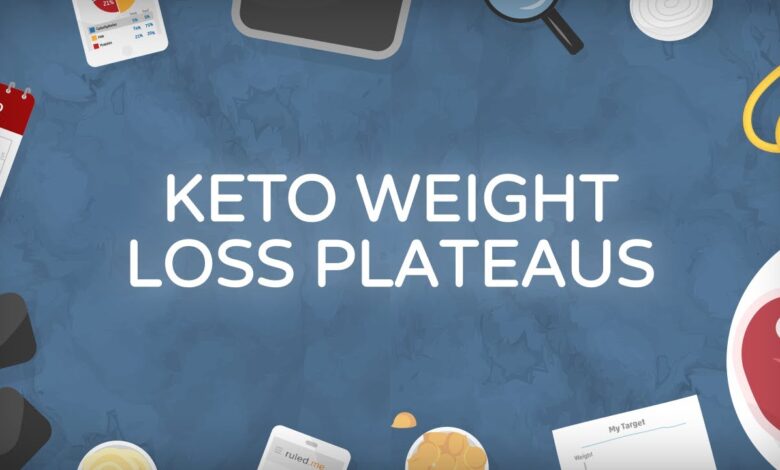Mastering Keto Weight Loss Plateau: How to Break Through the Stall and Reignite Fat Loss

If you’ve been riding the momentum of the Ketogenic Diet and suddenly hit that dreaded stop-sign where the scale refuses to budge—you’re not alone. In this deep-dive, conversational, friendly guide we’ll explore everything you need to know to bust through a keto weight loss plateau and get your fat-burning engine roaring again. We’ll talk science, lifestyle tweaks, mindset, global relevance (from Africa to Europe to the U.S.), and high-impact words that speak to the many, not just a few. Let’s jump in.
Read Also How to Overcome Keto Plateaus: Proven High-Impact Strategies
Why Do Plateaus Happen on Keto?
Plateaus are frustrating. One week you’re shedding fat and feeling unstoppable; the next week you’re stuck. But understand this: plateaus are totally natural. On keto specifically, a variety of mechanics can kill your momentum.
First, let’s talk metabolism. When you lose fat, your body’s energy needs drop. Your total daily energy expenditure (TDEE) decreases. (Ruled Me) So those calories you were comfortably eating last month might now just maintain your current weight instead of pushing fat-loss.
Second, hidden carbs and excess calories sneak in. On a well-formulated keto diet you should keep carbs very low (generally under 20-50 g/day) so your body remains in ketosis and burns fat. But many people underestimate carbs from sauces, dressings, “keto-friendly” substitutes, nuts, low-carb bars, etc. (Healthline) These hidden carbs can stall fat-loss by increasing insulin or preventing full ketosis.
Third, lifestyle factors: stress, poor sleep, lack of activity, too much or too little exercise, insufficient protein—all of these can contribute. For example, high cortisol from chronic stress can encourage your body to store fat, especially around the mid-section. (Healthline)
Finally, adaptation. Your body doesn’t like change—it works to resist weight loss. It may reduce “non-exercise activity thermogenesis” (NEAT), your metabolic rate may drop, thyroid activity may adjust downward. These survival mechanisms were meant to help our ancestors in famine situations. (Ruled Me) So what appeared as initial rapid weight loss slows, and then plateaus. Good news: you can break through, with the right strategy.
What’s a Real Keto Plateau vs. Normal Slow-down?
Not every slowdown means something is wrong. It helps to distinguish a true plateau from a natural deceleration in weight loss.
- When you first start keto, there’s often rapid weight loss—but that’s mostly water weight, glycogen depletion, and shifts in fluid balance. (Healthline)
- Once you move past that phase, fat loss is slower, steadier. A stall for a week or two may just mean your fat-loss is slow but ongoing.
- A true plateau means no change in weight (or body fat) for several weeks despite consistent diet, activity, and state of ketosis. It suggests adaptation and needs an intervention. (Perfect Keto)
- Also important: even when the scale doesn’t move you may still be improving in other ways—looser clothing, more energy, improved metabolic markers. (Healthline)
So before you panic, ensure you’ve given it enough time, tracked your macros and carbs, and remained consistent. If those boxes are ticked and you’re still stuck? Time to apply some plateau-busting strategies.
Bold Heading: The Core Strategies to Break Your Keto Plateau
1. Reassess Your Macros & Calories
On keto many people assume “low carb = automatic fat loss” and they skip tracking calories. But if you’re consuming too many calories (even from fat) or have not updated your macros after losing weight, you’re likely stuck.
- Use a macro calculator to determine your new maintenance calories and then subtract a moderate deficit based on how much more fat you want to lose. (Ruled Me)
- Ensure your protein is adequate (to maintain muscle), your carbs remain low enough to support ketosis, and fat is used as a fuel, not just as unlimited calories. (Ruled Me)
- Track hidden calories and carbs—those “keto snacks” and dressings add up. (Healthline)
2. Cut Hidden Carbs & Check Ketosis
Despite being “on keto” you may be slipping out of ketosis. Hidden carbs from sauces, nuts, certain veggies, “low-carb” substitutes can accumulate. (Virta Health)
- Check for net carbs versus total carbs.
- Consider using keto strips or measuring ketone bodies to confirm you’re in nutritional ketosis.
- Reduce cheat meals and avoid “just one bite” slips which can delay ketone production and fat burning. (Ruled Me)
3. Change Up Your Physical Activity
When weight loss stalls, doing more of the same doesn’t always work. Your body adapts. So you might need to vary intensity, frequency, or style of workout.
- Incorporate resistance training (weight lifting) 2-4 times/week to build/maintain muscle, which boosts metabolic rate. (Ruled Me)
- Add high-intensity interval training (HIIT) or more NEAT (standing more, walking, moving hourly) to raise calorie burn without overtraining. (Healthline)
- Be careful not to overtrain—excessive cardio without adequate recovery can suppress metabolism. (Ruled Me)
4. Manage Stress, Optimize Sleep & Recovery
Lifestyle factors often overlooked—but they make or break progress.
- Poor sleep leads to hormonal imbalances (ghrelin, leptin) that increase hunger and slow metabolism.
- High chronic stress triggers cortisol, promoting fat storage especially around belly region. (Healthline)
- Ensure you get 7-9 hours of quality sleep, schedule rest days, include relaxation practices (deep breathing, meditation, light yoga).
5. Consider Intermittent Fasting or Diet Breaks
When you’re stuck, changing the “when you eat” pattern helps. For example:
- A 16/8 intermittent fasting window (fast 16 hours, eat in 8 hours) can boost fat-burning and improve insulin sensitivity. (Healthline)
- A planned diet break: temporarily raising calories to maintenance for 1-2 weeks can sometimes reset metabolism and hormones and break the stall. (Ruled Me)
6. Evaluate Medical or Hormonal Issues
If you’ve done everything right and still stuck, it might be something deeper: thyroid function, insulin resistance, medications, underlying metabolic conditions. (Perfect Keto)
- Consider talking to your healthcare provider, get labs done (TSH, fasting insulin, glucose, lipid profile).
- Ensure you don’t have hidden issues (sleep apnea, PCOS, medications) that compromise fat-loss.
7. Stay Consistent & Track Non-Scale Victories
A plateau doesn’t mean overhaul everything immediately—it often means reinforce the basics, track, and persist.
- Use a food-tracking app to monitor intake—accuracy matters. (Ruled Me)
- Track body measurements, waist circumference, body fat %, how your clothes fit—these matter independently of the scale. (Healthline)
- Remember: slow progress is still progress. Celebrate energy improvements, better sleep, improved health metrics.
How to Tailor Your Approach: Africa, U.S., Europe – what to consider?
While the underlying physiology of a keto plateau is the same globally, there are regional nuances to consider—so you can adjust your strategy to your local lifestyle (whether you’re in Ghana, the U.S., or across Europe).
Dietary Availability & Food Culture
- In many African countries, staple carbs (cassava, yam, rice, plantain) are deeply ingrained. Transitioning to very low-carb keto means adapting local cuisines (e.g., making large salads, using local low-carb greens, switching plantain for grated cauliflower).
- In the U.S. & Europe you’ll often find a wide array of “keto-friendly” convenience foods—but beware: many are calorie-dense and carb-light but still can stall weight loss due to calories or additives.
- Use local, whole foods: eggs, fish, poultry, avocado, local vegetables, olive oil, coconut oil. The less processed, the better.
Lifestyle & Physical Activity Differences
- In some African settings, NEAT may already be higher (walking, outdoor chores) which helps. But gym infrastructure may be less accessible—so focus on bodyweight training, outdoor intervals, walking.
- In U.S. & Europe, sedentary jobs are common—so boosting NEAT (standing desks, walking meetings, hourly breaks) is key.
- Tailor your strength training to what’s accessible (home workouts vs gym vs outdoor calisthenics) and integrate it consistently.
Stress, Sleep, and Environment
- Sleep quality can vary widely: shared rooms, electricity outages, community noise. Address sleep environment (earplugs, blackout curtains, routine) to boost recovery.
- Stressors differ: economic stress, social factors, commute hassles. Each increases cortisol and stalls weight loss. Focus on what you can control (routine, meal prep, rest days).
- Weather and climate matter: hot climates may reduce appetite but increase fluid loss—stay hydrated and maintain mineral balance (sodium, potassium, magnesium) especially on keto.
Step-by-Step Plan to Break Your Keto Plateau (30-Day Action Plan)
Let’s give you a practical blueprint. If your weight has stalled, follow this 30-day plan. Adjust timelines to your pace, but keep momentum.
Week1 – Audit & Reset
- Track everything you eat for the next 7 days: use a food app. Include hidden carbs, sauces, nuts, “keto snacks”.
- Recalculate your macros based on your current weight, activity level, and target fat-loss. Adjust calories to a moderate deficit (e.g., 10-20% below maintenance).
- Check your carb intake: aim for net carbs 20-50 g/day (adapt to your context) and ensure you’re in ketosis (either via testing or symptoms: breath-acetone, reduced appetite).
- Increase your NEAT: stand more, walk for 30 minutes/day, take stairs, move hourly.
W 2 – Switch Up the Workout & Recovery
- Integrate 2-3 resistance training sessions (bodyweight or weights) focused on major muscle groups.
- Add 1 HIIT or vigorous cardio session (20 minutes max) plus 1 active recovery (walking, stretching).
- Prioritize sleep: aim for 7-9 hours/night. Create a bedtime routine, reduce screen time.
- Start stress-management: 10 minutes/day of deep breathing, journaling, or a relaxing hobby.
W 3 – Implement Advanced Tactics
- Introduce intermittent fasting (if suitable). Try an 8-hour eating window, 16-hour fast.
- Consider a “mini diet break”: if you’ve been in a large deficit for months, eat at maintenance calories for 3-4 days (not a binge—just enjoy maintenance) to refresh hormones/metabolism. (Ruled Me)
- Check your protein: ensure you’re getting at least 0.8-1.0 g per pound of lean body mass (or the regional equivalent) depending on your muscle-preservation goals. (Ruled Me)
- Hydrate well and manage electrolytes (on keto, sodium/potassium/magnesium matter even more).
W 4 – Monitor, Adjust & Scale
- Review your weight, waist measurements, body-fat indicators, how clothes fit, energy levels.
- If you’re losing again—good! Continue the plan.
- If the plateau persists: further reduce calories slightly OR increase non-exercise activity more OR vary your workout more (try different modalities: swimming, cycling, circuit training).
- Plan for sustainability: how will you maintain fat loss once you begin to reach your target? Consider a “maintenance phase” or cyclical keto strategy (cycles of keto + moderate carbs) for long-term success.
Nutrition Deep Dive: What to Eat and What to Avoid on Keto Plateau-Break Mode
When you’re trying to break a keto plateau, nutrition isn’t just about “low carb” anymore—it’s about smart, nutrient-dense, metabolically supportive food choices.
What to Eat More Of
- High-quality animal and plant protein: eggs, poultry, fish, lean beef, tofu, tempeh. Adequate protein helps preserve muscle, boosts thermic effect of food (TEF) and keeps metabolism higher. (Healthline)
- Healthy fats: avocado, olive oil, coconut oil, nuts (in moderation), fatty fish (omega-3s). These support ketosis and satiety.
- Low-carb, high-fiber vegetables: spinach, kale, broccoli, cauliflower, zucchini. Fiber supports digestive health and helps you feel full.
- Hydration + electrolytes: On keto your kidneys excrete more sodium, so you may need to add a little extra salt, potassium-rich veggies, magnesium supplementation if needed (after consulting with a healthcare provider).
- Whole, minimally processed foods: The more natural the food, the less likely you’ll hide unexpected carbs or additives.
What to Avoid / Minimize
- “Keto snacks” and “low-carb” processed foods: These may be low in carbs but high in calories, may impair metabolism or contain hidden sugars. (Healthline)
- High-calorie fat bombs / nut butters: Nuts and nut butters are great but easy to overconsume because they taste good and are calorie-dense. Overshooting calories stalls fat loss.
- Frequent cheat meals / high-carb days: While some people use strategic carb re-feeds, uncontrolled cheat days can knock you out of ketosis and reset fat-loss momentum.
- Sugary condiments, sauces, dressings: Check labels—many contain hidden sugars, thickeners or high-glycemic ingredients. (Virta Health)
Mindset & Behavior: Why You Haven’t Done This Already and How To Win
Let’s be real: busting through a plateau isn’t just about macros and workouts—it’s about you. Your beliefs. Your environment. Your behaviors. Let’s talk mindset.
Embrace the Slow Burn
You may have started your keto journey with expectations of rapid weight loss. And you got that—initially. Then the slowdown hits and it can feel like defeat. But think of it like a long-haul plane flight: you ascend quickly, then you cruise. Plateaus are the cruise phase. You’re still moving, just not as dramatically. Recognize that building a sustainable fat-loss trajectory is more important than frantic drop-offs that rebound later.
Habit Over Perfection
Because you’re human. Life happens. Vacation, stress, social events. The key is resilience—not perfection. Choose two non-negotiables this month (e.g., track food daily, resistance train 3x/week). Everything else is supplementary. Consistency beats intensity when you’re stuck.
Visualise Your Success
Picture yourself after you break the plateau: lighter, fitter, energized, confident. How do you feel? Who are you with? Where are you? Hold that vision. Motivation drops when progress slows—but reminding yourself of the why keeps you going.
Accountability & Support
Find a buddy, join a group (online keto communities, local fitness groups), share your wins and struggles. When you’re stuck, others may provide creative ideas, motivation, or simply empathy. Remember—this is a global community (Africa, U.S., Europe) and you’re not alone.
Specific Considerations for Women, Older Adults & Medical Conditions
While much of the advice applies universally, some populations need extra nuance.
Women
Hormones (menstrual cycle, menopause) influence weight loss more than you might expect. Plateaus in women may be influenced by estrogen, progesterone, thyroid changes. Ensure you’re getting adequate iron, calcium, and your calorie deficit is not too extreme (which can disrupt hormonal balance).
Older Adults / Lower Muscle Mass
As you age you lose muscle mass naturally (sarcopenia). On keto, maintaining/gaining muscle is crucial to keep metabolism up. Emphasize resistance training, slightly higher protein, ensure vitamin D, calcium, and bone health support.
Medical Conditions (e.g., thyroid, PCOS, insulin resistance)
- If you have a diagnosis of hypothyroidism, PCOS, diabetes: your weight loss may be slower and you’ll benefit from medical supervision.
- On keto your insulin sensitivity often improves—but you still need to monitor blood sugar and medications if relevant.
- Plateaus in these groups may require deeper investigation: labs, hormone panels, medication adjustments, diet fine-tuning.
Tracking Progress Beyond the Scale
When you’re battling a plateau, the scale can lie. Don’t rely solely on it. Use these additional metrics:
- Waist circumference / waist-to-hip ratio: As you lose fat, your midsection often changes before the scale moves.
- Body-fat percentage (if you have access via calipers, DEXA, or good body-fat scale).
- How your clothes fit: Are your jeans looser? Are you less bloated?
- Energy, mood, sleep quality: On a good diet your energy will often improve even if weight stalls.
- Blood markers: In many places (U.S., Europe, increasingly Africa) you can track triglycerides, HDL/LDL cholesterol, fasting insulin, blood-glucose. Improvements here signal metabolic health gains—even if the weight number is stuck. (Healthline)
Celebrate these victories—they tell you you’re moving forward.
Common Mistakes That Keep You Stalled
Let’s highlight typical mis-steps so you can sidestep them:
- Eating “keto” but not tracking calories → calorie surplus despite low carbs.
- Under-eating or too large a deficit → metabolism says “whoa” and slows down. (Ruled Me)
- Ignoring hidden carbs (sauces, dressings, “low-carb” treats).
- Overestimating exercise calories burned and compensating with extra food.
- Skipping strength training and relying purely on cardio.
- Poor sleep and high stress—often underestimated.
- Being impatient—abandoning keto too soon when the scale pauses.
Recognize these and correct them, and you’re well on your way.
Lifestyle Adjustments That Support Long-Term Success
To avoid future plateaus and maintain your fat-loss, adopt these lifestyle supports:
- Meal preparation: On busy days you’re more likely to slip into hidden carbs or high-calorie fats. Plan your meals ahead.
- Stay hydrated: Keto increases water and electrolyte loss, and dehydration may reduce performance and slow fat loss.
- Mindful social eating: In many cultures (Africa, U.S., Europe) food is social. Plan ahead for events, bring keto-friendly dishes, or strategize your cheat/maintenance meals.
- Periodic re-evaluation: Every 8-12 weeks revisit your macros, activity level, body composition, lifestyle changes. As you lose weight you need fewer calories. If you ignore that, you’ll stall.
- Flexible sustainability: You might adopt a “keto-maintenance” phase where you raise carbs slightly but keep fat loss or maintenance going. Some call this “keto 2.0” or cyclical keto. It’s not a free pass, but a tool for sustainability.
Real-World Success Stories & Motivation
Remember that community out there making progress—even when they hit plateaus. On forums like r/keto someone posted:
“Started 278lbs… rapidly lost … plateaued at ~241 for a month… last week broke through to 234.” (Reddit)
What can we learn from this? Persistence, tracking, consistency—and then breakthrough. Your story might mirror this.
Picture someone in Accra, Ghana, adjusting their diet to include more low-carb local greens and fish, walking in the heat, managing stress of city life—all bits of lifestyle adding up. Or someone in London or New York juggling a desk job, sleep debt, gym sessions and social life. The tools are the same—macro tracking, carb vigilance, exercise, rest. The context differs—use the tools that align with you.
When to Seek Professional Help
If you’ve applied the above strategies diligently for 4-6 weeks and still find no progress, consider:
- Seeing a registered dietitian who understands keto and metabolic plateaus
- Getting lab work: thyroid panel, fasting insulin, glucose, lipid profile, vitamin D, electrolytes
- Assessing medications (some medications slow metabolism or cause weight gain)
- Evaluating for sleep disorders (sleep apnea), hormonal imbalance (PCOS, menopause), gut health issues (which may interfere with nutrient absorption).
It’s not a failure—it’s smart. Sometimes the body needs more than just “diet and gym”—it needs tailored care.
Myths & Misconceptions about Keto Plateaus
Let’s debunk a few:
- Myth: “If I’m eating strict keto, I should never hit a plateau.”
Reality: Even the best keto diets will plateau if calories, carbs, activity, or metabolism change. (Ruled Me) - Myth: “Metabolism stops entirely when plateau hits.”
Reality: It slows somewhat, but with the right strategies you can reignite fat-burning. - Myth: “A cheat day will break my plateau.”
Reality: Often cheat days knock you out of ketosis, bring back water weight, derail momentum. Better to apply well-planned carb re-feeds if needed. - Myth: “I must eat less and less every month.”
Reality: Too large a deficit increases adaptation and plateau risk. Sometimes increasing calories to maintenance briefly helps. (Ruled Me)
How to Transition Out of the Plateau Phase Into Sustainable Maintenance
Once you’ve broken the plateau and are losing fat again, shifting into a sustainable phase is key for long-term success (especially if you’re thinking of maintenance instead of continued aggressive fat loss).
- Gradually raise calories toward your new maintenance (based on your new weight).
- Keep macro tracking light but consistent—food awareness is your friend.
- Introduce flexible dieting: allow more variety, occasional carbs, but maintain otherwise.
- Keep strength training and NEAT high—this helps prevent regain.
- Monitor your body and habits monthly: if you see slow creeping of weight upward, apply moderate self-check.
- Remember: maintenance is not unlimited—it’s a healthy, stable state, not a free-for-all.
Conclusion
Breaking a plateau on the ketogenic diet doesn’t mean you failed—it means your body adapted. And adapting demands a strategic reboot: tighten your macros, reduce hidden carbs, optimize activity, manage stress and sleep, consider intermittent fasting or diet breaks, and track smarter. Whether you live in Accra, London, New York, or anywhere in between—the tools are universal, your context is unique.
Stay consistent, track not just weight but energy, measurements, and how you feel. Use community, stay flexible, address underlying health, and remember—slow progress is still progress. Fat-loss is a marathon, not a sprint. When you apply these strategies, you’ll bust that plateau and reclaim your momentum.
Read Also 6 Must-Have Ingredients for Low-Carb Meal Prep: Ultimate Guide for Busy Weeks
FAQs
1. Why did my weight stop dropping even though I’m still eating low-carb on keto?
You may still be eating too many calories (even from fat), hidden carbs may have crept in, or your metabolism has decreased due to weight loss. Reassess macros, track intake, and adjust your calorie deficit accordingly. (Ruled Me)
2. Does being in ketosis guarantee continuous fat-loss?
No—being in ketosis means your body is burning fat for fuel instead of carbs, but fat-loss still depends on a calorie deficit, metabolic rate, and lifestyle factors. Even in ketosis, if your calories are at maintenance or surplus, weight loss will stall. (Healthline)
3. How long should I wait before calling it a plateau and taking special action?
If you’ve had no measurable weight or fat-loss (and no improvement in other markers) for 3-4 weeks despite consistent diet and exercise, you can consider it a plateau. Use that as a trigger to apply the strategies above.
4. Can intermittent fasting help break a keto plateau?
Yes—intermittent fasting (such as 16/8) when combined with keto can enhance fat burning, lower insulin levels, and support metabolic flexibility. But it must be done thoughtfully: ensure you’re still eating enough protein, nutrients, and not over-restricting. (Healthline)
5. What if I have underlying health issues (thyroid, PCOS, hormone imbalance) — can I still break the plateau?
Absolutely—but you may need a gentler, more personalized approach, and possibly medical supervision. Addressing hormonal imbalances, optimizing sleep, and monitoring labs will help. Plateaus in these cases are common, so extra patience and tailored adjustments are essential.




